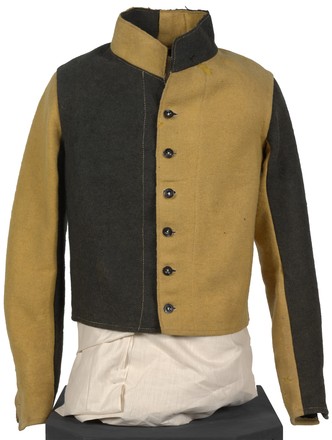Convict jacket
c1840
Felted wool
Bequest of Sir William Dixson, 1952
DR 114
This short-bodied convict jacket dates from the final years of the convict system in Australia. It is thought to have been used at Port Arthur in Van Diemen’s Land (Tasmania). Yellow, the traditional colour of disgrace, was generally reserved for prisoners who had re-offended.
In 1839 a report was sent with dispatches from chief police magistrate M Forster in Van Diemen’s Land to the Colonial Office in London recommending 10,000 suits of half black and half yellow – 10,000 suits all yellow – and 10,000 suits of grey clothing be sent from the Ordinance Department. This is perhaps one of them.
Magpies and canaries
Known as ‘magpie’ suits,
multi-coloured convict uniforms were introduced into the Australian colonies in
1814 by Governor Macquarie. They were intended for re-offending convicts
assigned to chain gangs, with the distinctive and highly visible appearance
making escape more difficult.
The first multi-coloured
uniforms were half black and half white, with the yellow and black version
introduced some time later. The trousers, instead of being stitched along the
outside legs, were fastened with buttons about 15 cm apart so that prisoners could
get dressed and undressed while wearing leg irons.
All yellow uniforms were
also used. These were mostly issued to Irish political prisoners, with wearers
referred to as 'canaries'.
The deepest disgrace
‘… The day after the capture
of our friends, we were ordered to be dressed in “magpie” and changed to
another station, where were a number of soldiers stationed. This “magpie” suit
is intended for chain gangs and doubly convicted prisoners, and is ordered by
government as a badge of the deepest disgrace. It is composed of black and
yellow cloth, of the same quality as the grey. The left side of the front part
of the body, with the front of the left arm and leg, together with the right
side of the back part of the body were yellow, whilst the remainder was black.
The suits were all of a size, or with but a slight variation, and were
distributed to us as we stood in rank, without regard to their fitting our
persons. The consequence was we got all sorts of fits. Some short fellow having
a pair of breeches quite large enough for a child of Anak [a biblical giant] …
a more motley, grotesque group, could not be well imagined. Knowing the change
was made for the purpose of mortifying and humbling our spirits, we strove the
harder to deceive our masters as to our real feelings, and I believe we succeeded
pretty well in the matter. Indeed most of us could not have helped having a bit
of frolic, when we looked so fantastic. We danced about, and shouted and sung
songs as though we were in a real, perfect delirium of joy. A few cursed and
swore like madmen possessed.’*
Convict William Gates, imprisoned at Lovely Banks station
in Van Diemen’s Land, 1840
Footnotes
* From G
Mackaness (ed), Recollections of Life in Van Diemen’s Land, 1961, p 62



 Back to list
Back to list